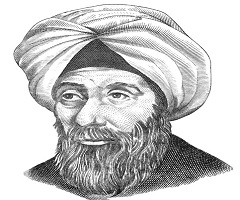Musa Al Khwarizmi Inventor of Algebra

Biography of Muhammad Ibn e Musa al Khwarizmi
Early Life
Muhammad Ibn e Musa al Khwarizmi inventor of Algebra was born in Baghdad in 780 A.D. His early life is not evident in most books yet what we know is that as his name suggests he came from Khwarzem origin also known as Khiva in Uzbekistan. Some people believe that he came from Khorasan.
Initial Work
During the reign of the sixth Abbasid ruler Al Ma’mun, a son of Harun Al Rashid, Baghdad became a genuine centre of learning. Al Ma’mun transformed the “Bait Al Hikmah” (House of Wisdom) academy into a premier centre of scientific research and teaching by inviting several scholars, including Al Khwarizmi, to work there. Thus he and his family shifted to south of Baghdad because Al Mamun wanted him to be his court astronomer. The academy boasted a unique library of manuscripts that rivaled and even surpassed that of Alexandria, one that made available to Muslim scholars everything that was worth having from Byzantium. This delighted Al Khwarizmi, who first translated several Greek philosophical and scientific works, before delving into the study of geometry and astronomy. Mohammad Musa Al Khwarizmi studied algebra, geometry, and astronomy there and thus began his journey improving and achieving many scientific fields. After Muhammad Musa Al Khwarizmi received his education he was influenced by another scholar called Abu Kamel. Al Khwarizmi, after being influenced by the aforementioned scholar, went on to create several branches in mathematics.
Inventor of Algebra
Admittedly, his most significant innovations came with “Hisab Al Jabr wal- Muqabalah”, which defined the study of algebra, which is regarded as cornerstone of the sciences. He also developed the concept of algorithms in mathematics He also wrote an important work on astronomy, covering calendars, calculating true positions of the sun, moon and planets, tables of sines and tangents, spherical astronomy, astrological tables, parallax and eclipse calculations, and visibility of the moon. The shadow square, an instrument used to determine the linear height of an object, in conjunction with the alidade for angular observations, was also invented by al-Khwarizmi in ninth-century Baghdad.
Algebra
Al Khwarizmi’s discussions of equations were limited to the first and second degrees, which were composed of units, roots and squares. For example, a unit was presented as a number, while a root was x, and a square was x2. Still, Al Khwarizmi’s mathematics was done entirely in words rather than symbols, which may surprise contemporary scientists. The common equation (linear or quadratic) was reduced in his book to one of six standard forms:
1. Squares equal to roots. Example: ax2 = bx
2. Squares equal to numbers. Example: ax2 = b
3. Roots equal to numbers. Example: ax = b
4. Squares and roots equal to numbers. Examples: ax2 + bx = c or x2 + 10 x = 39.
5. Squares and numbers equal to roots. Examples: ax2 + c = bx or x2 + 21 = 10 x.
6. Roots and numbers equal to squares. Examples: ax2 = bx + c or 3x + 4 = x2.
This reduction process was carried out using the two operations of Al Jabr and Al Muqabalah, where Al Jabr meant completion and Al Muqabalah meant balancing. Yet al Khwarizmi’s algebra did not look like the current algebra we use. Al-Khwarizmi’s book is written entirely in prose, with none of the symbols we use today. Here is an example:
If the instance be, ‘ten and thing to be multiplied by thing less ten,’ then this is the same as ‘if it were said thing and ten by thing less ten. You say, therefore, thing multiplied by thing is a square positive; and ten by thing is ten things positive; and minus ten by thing is ten things negative. You now remove the positive by the negative, then there only remains a square. Minus ten multiplied by ten is a hundred, to be subtracted from the square. This, therefore, altogether, is a square less a hundred dirham’s.
Death
Muhammad ibn Musa al-Khwarizmi died in c. 850 being remembered as one of the most seminal scientific minds of early Islamic culture. Al Khwarizmi was a prolific writer on Hindu-Arabic numerals.


Leave a Reply